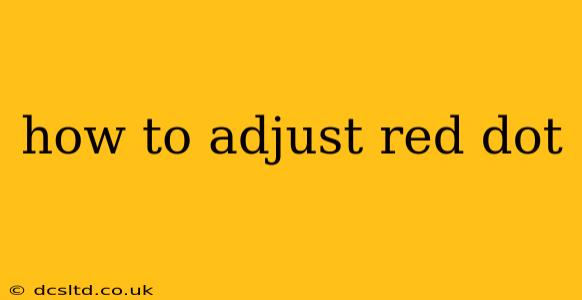How to Adjust Your Red Dot Sight: A Comprehensive Guide
Red dot sights have revolutionized aiming, offering a fast, intuitive aiming system for various firearms. However, properly adjusting your red dot is crucial for accuracy. This guide will walk you through the process, addressing common questions and providing tips for optimal performance.
Understanding Your Red Dot Sight Adjustments
Most red dot sights use windage (left/right) and elevation (up/down) adjustments. These are typically controlled via small turrets or dials located on the sight itself. These adjustments are usually measured in minutes of angle (MOA) or clicks. One MOA equals approximately one inch at 100 yards. Understanding your sight's specific adjustment increments is vital for precise zeroing. Always refer to your sight's manual for specific instructions and adjustment values.
H2: What are the common adjustment methods for red dots?
Red dot sights generally employ two main adjustment methods:
- Turret Adjustments: These are the most common. Small dials or turrets are turned to adjust the point of impact. They often feature click stops for precise adjustments, and some have markings indicating the number of clicks.
- Zero Stop: Some higher-end sights include a zero stop feature. This prevents you from accidentally over-adjusting and losing your zero. It's a safety feature that ensures your adjustments remain within a usable range.
H2: How do I zero my red dot sight?
Zeroing a red dot involves adjusting the sight until the point of impact matches the point of aim at a specific distance (typically 25 yards for pistols and 50-100 yards for rifles). This is a step-by-step process:
- Safe Gun Handling: Always follow safe gun handling practices. Ensure the firearm is unloaded and pointed in a safe direction.
- Secure Rest: Use a stable rest, such as a shooting bench or sandbags, to minimize movement during adjustment.
- Initial Sighting: Fire a few shots at your chosen target distance. Note the point of impact relative to the center of your red dot.
- Adjustments: Based on the point of impact, adjust the windage and elevation turrets to correct the point of aim. Remember, windage adjusts left/right, and elevation adjusts up/down. Consult your sight's manual for the direction of adjustment for each turret.
- Iterative Process: Fire more shots after each adjustment until the point of impact is consistently on target. This often involves several adjustments and test shots.
H2: My red dot is blurry; how do I fix it?
Blurriness can stem from several sources:
- Eye Relief: Incorrect eye relief (distance from the eye to the rear lens) leads to a blurry image. Experiment with positioning your eye to find the optimal distance.
- Lens Focus: Some red dots have an adjustable focus. If so, use this adjustment to sharpen the reticle.
- Dirty Lens: Clean the lens with a microfiber cloth and appropriate lens cleaner. Dust, smudges, or debris can significantly affect clarity.
H2: How do I adjust the brightness of my red dot?
Most red dot sights offer adjustable brightness. This is essential for different lighting conditions. A very bright reticle in low light can be distracting, whereas a very dim reticle in bright light can be difficult to see. Use the brightness adjustment to optimize visibility in your specific environment.
H2: Why is my red dot sight drifting?
Drifting refers to the point of impact shifting over time, even without adjustments. This can be caused by several factors:
- Loosening of Mounting Hardware: Ensure that the sight is securely mounted to the firearm and that all screws are tightened.
- Mechanical Issues: In rare cases, internal parts within the sight might become worn or damaged, leading to drifting.
Conclusion:
Adjusting your red dot sight is a straightforward process that significantly improves accuracy and shooting performance. By understanding your sight's features, following safe practices, and employing the iterative process of adjustment and verification, you can confidently zero and maintain your red dot sight for optimal results. Remember to always consult your specific sight's manual for detailed instructions and specifications.
